
Richard Buckminster Fuller was an American architect, systems theorist, writer, designer, inventor, philosopher, and futurist. He styled his name as R. Buckminster Fuller in his writings, publishing more than 30 books and coining or popularizing such terms as "Spaceship Earth", "Dymaxion", "ephemeralization", "synergetics", and "tensegrity".

In geometry, the truncated icosahedron is an Archimedean solid, one of 13 convex isogonal nonprismatic solids whose 32 faces are two or more types of regular polygons. It is the only one of these shapes that does not contain triangles or squares. In general usage, the degree of truncation is assumed to be uniform unless specified.

A world's fair, also known as a universal exhibition or an expo, is a large international exhibition designed to showcase the achievements of nations. These exhibitions vary in character and are held in different parts of the world at a specific site for a period of time, typically between three and six months.

The 1967 International and Universal Exposition, commonly known as Expo 67, was a general exhibition from April 28 to October 27, 1967. It was a category one world's fair held in Montreal, Quebec, Canada. It is considered to be one of the most successful World's Fairs of the 20th century with the most attendees to that date and 62 nations participating. It also set the single-day attendance record for a world's fair, with 569,500 visitors on its third day.

A geodesic dome is a hemispherical thin-shell structure (lattice-shell) based on a geodesic polyhedron. The triangular elements of the dome are structurally rigid and distribute the structural stress throughout the structure, making geodesic domes able to withstand very heavy loads for their size.
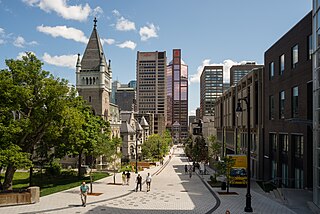
The architecture of Montreal, Quebec, Canada is characterized by the juxtaposition of the old and the new and a wide variety of architectural styles, the legacy of two successive colonizations by the French, the British, and the close presence of modern architecture to the south. Much like Quebec City, the city of Montreal had fortifications, but they were destroyed between 1804 and 1817.

The Indians of Canada Pavilion was a pavilion at the 1967 International and Universal Exposition in Montreal, Quebec, Canada.

The Climatron is a greenhouse enclosed in a geodesic dome that is part of the Missouri Botanical Garden in St. Louis. Initiated by then Garden director Frits W. Went, the dome is the world's first completely air-conditioned greenhouse and the first geodesic dome to be enclosed in rigid Plexiglass (Perspex) panels. Completed in 1960, it was designed by T. C. Howard, of Synergetics, Inc., Raleigh, North Carolina. The broad climatic range within the dome, which recreates a lowland rain forest, is achieved by sophisticated climate controls without using interior partitions.

Spaceship Earth is a dark ride attraction at the Epcot theme park at the Walt Disney World in Bay Lake, Florida. The geodesic sphere in which the attraction is housed has served as the symbolic structure of Epcot since the park opened in 1982.
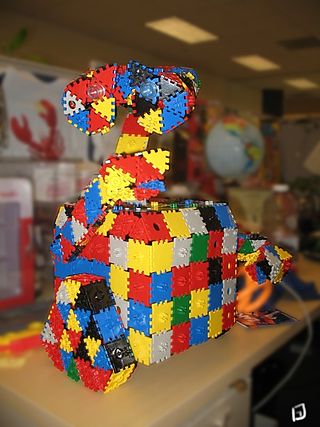
Zaks is a construction toy originally produced in Canada by the company Irwin Toy in 1987 and released in the United States by Ohio Art Company in 1988. The toy is a system of multicolored flat plastic triangle and square pieces that interlock via snap lock hinges along their edges, creating moveable structures. The toy includes additional pieces such as columnar joint attachments, push-in eyes, clear bubbles, cones, and antennae.
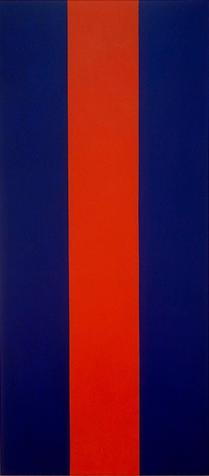
Voice of Fire is an 1967 acrylic on canvas abstract painting made by American painter Barnett Newman in 1967. It consists of three equally sized vertical stripes, with the outer two painted blue and the centre painted red. The work was created as a special commission for Expo 67. In 1987 it was loaned to the National Gallery of Canada in Ottawa, Ontario, Canada.
Gerald Gladstone was a Canadian sculptor and painter.

Jean Drapeau Park is the third-largest park in Montreal, Quebec, Canada. It comprises two islands, Saint Helen's Island and the artificial island Notre Dame Island, situated off the shore of Old Montreal in the Saint Lawrence River.

The Expo 67 International and Universal Exposition featured 90 pavilions representing Man and His World, on a theme derived from Terre des Hommes, written by the famous French pilot Antoine de Saint-Exupéry.

Robert Edward Williams is an American designer, mathematician, and architect. He is noted for books on the geometry of natural structure, the discovery of a new space-filling polyhedron, the development of theoretical principles of Catenatic Geometry, and the invention of the Ars-Vivant Wild-life Protector System for repopulating the Western Mojave Desert in California, USA with desert tortoises.

The Expo Axis is one of the world's largest membrane roofs. It spanned the entrance and boulevard building of the World Exposition 2010 in Shanghai.
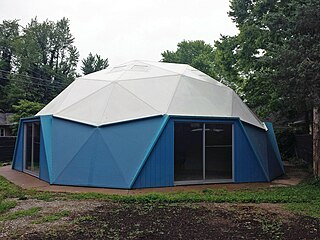
The R. Buckminster Fuller and Anne Hewlett Dome Home, located at 407 S. Forest Ave. in Carbondale, Illinois, is a geodesic dome house which was the residence of Buckminster Fuller from 1960 to 1971. The house, inhabited by Fuller while he taught at Southern Illinois University, was the only geodesic dome Fuller lived in, as well as the only property he ever owned. Fuller, a prolific architect and engineer, popularized the geodesic dome as a building design, and his house was one of the first geodesic dome residences to be constructed. The home was built and designed by Al Miller of the Pease Woodworking Company. While living in the home, Fuller was awarded nine patents, published eleven books, and designed the Montreal Biosphère, one of his most famous works.

Shoji Sadao was a Japanese American architect, best known for his work and collaborations with R. Buckminster Fuller and Isamu Noguchi. During World War II he was stationed in Germany and was a cartographer for the U.S. Army.
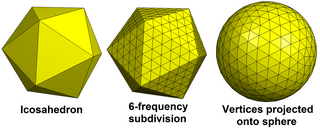
A geodesic polyhedron is a convex polyhedron made from triangles. They usually have icosahedral symmetry, such that they have 6 triangles at a vertex, except 12 vertices which have 5 triangles. They are the dual of corresponding Goldberg polyhedra with mostly hexagonal faces.





















